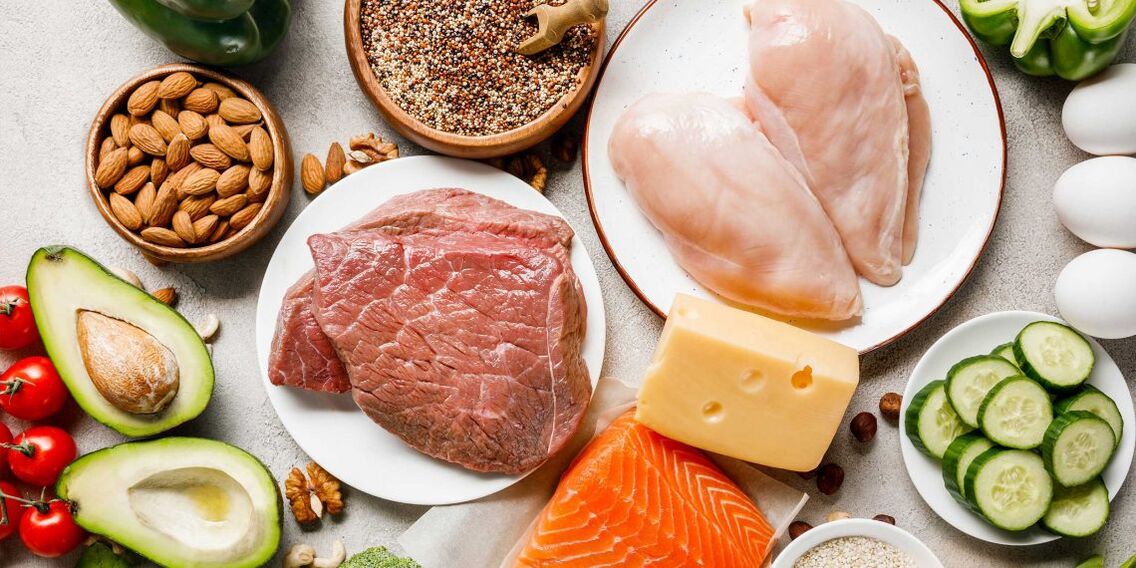In a ketogenic diet, eat many fatty foods and exclude all flour and sweet. 60-70% of all calories must come from fat, 20-30% protein and only 10% of carbohydrates. Special attention is paid to carbohydrates: it cannot eat more than 50 g per day, regardless of its weight and calorie consumption.

Fat can be obtained from vegetable oils and pork butter, meat and fish, cheese, sour cream, ugly yogurt, eggs and nuts. Most of these products also contain enough proteins to enter the daily speed: 1, 5–2 g per kilogram of body weight. You get carbohydrates only from vegetables, fruits and berries without sugar to gain enough vitamins. There are no family garrisons: cereals, pasta, potatoes. Absolute prohibition of sweets and alcohol.
Because it loses weight in a keto diet
Carbohydrates are the main fuel of the body. When you consume less than 50 g of carbohydrates per day, your reserves in the body are exhausted after one day, and the body begins to divide fat and use fatty acids for energy production. However, not all organs can eat fats: the brain simply needs glucose or some replacement.
To obtain glucose, the liver produces ketone bodies from fatty acids: acetate, which then becomes beta-hydroxybetics and nourishes the brain, heart, kidneys, muscles and other tissues. As an exchange product, acetone is formed, so its concentration in urine increases and breathing becomes sweet.
In general, ketones constantly occur in the body, their concentration in the blood is approximately 0. 2-0. 5 mmol/l. When its level grows to 0. 5–5 mmol/L, food ketosis occurs. It is not dangerous to health, unlike ketoacidosis, in which the concentration of ketone bodies increases to 10-25 mmol/l. This condition can occur when dying from hunger.
Despite the fact that it does not reduce the calorie content of the diet, in a state of ketosis the body begins to get rid of fat reserves. Since the blood glucose level strives by zero, the production of insulin hormone is inhibited, and with it lipogenesis is the deposition of fats in the reserve. In addition, the keto diet reduces its appetite, which also helps you lose weight: it does not consider calories and does not break.
How much can be launched in a ketogenic diet?
Everything is individual here. In a review of six studies dedicated to a ketogenic diet, participants lost 3 to 12 kg in six months. If we take the average value for all results in the review, approximately 6 kg will be 6 months.
Who should try a keto diet?
Despite the complexity of the first days and strict restrictions, the ketogenic diet is perfect for some people. It is worth trying:
- Those who love meat. If you cannot live without him and fatty products, and his diet is indifferent to sweets and bread, his option.
- Those who want to lose weight without losing muscle mass. The keto diet helps to throw fat, including visceral, and at the same time preserves dry muscle mass. In addition, the diet does not affect energy indicators, so it is quite suitable for power sports athletes. Although it will not work to increase the muscles.
- People with diabetes of the first and second type. Due to insulin production failures, diabetics are forced to take this hormone to avoid acute jumps in blood sugar. The keto diet greatly reduces its level. But before moving to Keto, you must consult a diet with the treating doctor.
- Those who want to keep the health of the brain. The keto diet has a positive effect on mental and emotional health, protects the brain from neurodegenerative diseases and helps with migraine and epilepsy.
- Those who wish to reduce the risk of atherosclerosis. The diet reduces the amount of cholesterol and "bad" fats in the blood and increases the percentage of "good".
- Those who are afraid of the keto cancer diet limit reactive oxygen forms and reduce inflammation, which is often associated with the appearance of oncology.
- Runners and athletes. If you are an athlete of a cyclical sport for resistance, the keto diet can improve your indicators.

Who cannot sit on a ketogenic diet
This diet is contraindicated:
- People with kidney and liver diseases, oxidation of fatty acids.
- Those who are dedicated to team sports, athletes, runners at medium distances. If classes imply a long stay in anaerobic mode, Keto Diet will reduce their indicators.
- People with fragile bones. The possible side effects of the diet include changes in the mineral composition of the bones, which can lead to an increase in the risk of fractures.
Is it difficult to adhere to a ketogenic diet?
The keto diet is not the lightest diet, especially at the beginning. When your body begins to experience glucose, ketoms of keto -gripp can manifest: nausea, vomiting, headaches, fatigue, dizziness, insomnia of constipation. They last 2 to 3 days to several weeks. In this case, you cannot consume more carbohydrates to relieve the condition.
If it breaks, the body will receive the desired glucose, it will leave ketosis and will have to repeat it again. This is the difficulty of maintaining a diet. On the other hand, this is your advantage: you know that after breakdown you will have to go through an unpleasant adaptation, so you will expect.
How to sit in a keto a genetic diet
A personal coach and nutritionist proposes to divide the entry period into a diet into several phases and adhere to certain rules.
1. Preliminary preparation (2-4 weeks)
Enter 40–80 g of coconut oil into the diet to provide triglycerides. They are rapidly absorbed, do not deposit in fats and are processed in the liver in ketone bodies. Instead of oil, you can consume a food supplement with dust -shaped ketones.
Reduce the amount of carbohydrates at 100 g per day. So you will not go into ketosis, but teach yourself that there are less carbohydrate foods.
2. Entering ketosis (4 days)
Day 1. Salta breakfast and lunch, hungry all day until night. At dinner, there should be no more than 200-300 kcal, 10-15 g of protein and 15-30 g of fat. Carb free.
Day 2. Eat the same portion for breakfast and lunch, for dinner, ⅔ on your usual part of food. Carb free.
Day 3. For breakfast and lunch, you can eat ⅔ From a regular food portion, prepare the full dinner. There are still no carbohydrates.
Day 4. Eat your usual portions, you can turn on necratic vegetables and sugar -free fruits.
During this training phase, it is better to replace with long walks. This will burn glucose and help enter cetosis faster. If you are on a walk, you think that the forces have ended on your legs, this is a good sign: glycogen reserves are almost exhausted.
Continue drinking coconut oil or carbohydrate dust, add vitamins and a drink with electrolytes.
3. Ceto adaptation (2-4 weeks)
You will need several weeks to adapt to the diet. At this time, you must support carbohydrates within 30 g per day, if it is compromised and 20 g - if not. Keep in mind that at the beginning the energy level will be slightly lower. This is normal and gradually happens. At this stage, it is no longer necessary to take carbohydrate dust.

How much to sit on a keto diet and how to get out so that the weight does not return
The keto genetic diet can last 3 to 4 weeks to a year. It makes no sense to adhere to a diet for less than three weeks, because during this time your body will pass the adaptation through the keto and will only begin to obtain all the advantages of this diet. As for the terms of more than a year, there are not enough scientific data to judge this, but eating like this is a bad idea. First, a prolonged keto diet increases the risk of liver obesity, hypoproteinemia, kidneys and deficiency of vitamins and minerals. Second, the abandonment of one of the macro elements does not affect the life of life in the best way. An analysis of the data of more than 15 thousand people showed that both excess and lack of long -term carbohydrates increase the risk of death. Older people whose diet consisted of carbohydrates in 50–55%.
Good news: it will not be so difficult to keep the weight after a diet diet.
With a conventional diet with a cut calorie content, Ghrelin Hunger hormone increases, due to which a person wants to eat all the time, decomposes and after the completion causes food. The study showed that with ketogenic changes they do not occur, so it would be easier for you to maintain weight. Another study testified that 40 days of a diet with a half -year break for the Mediterranean diet led to stable weight loss without a greater set.
The Mediterranean diet is a great option after keto. It also contains many fats to which it will get used to, and carbohydrates are consumed from useful sources: comprehensive products, vegetables and fruits. Unlike the keto diet, the Mediterranean can keep his entire life without health risks.















